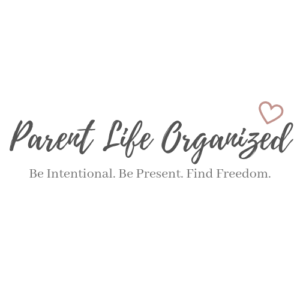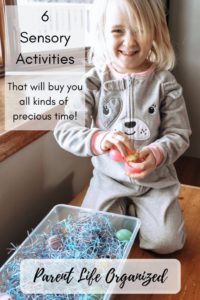
Hey there friends!
Today we want to share with you our #1 favorite way to keep the kiddos entertained, so that you can conquer that to-do list for the day, or maybe grab a much-needed shower!
We are going to talk about 5 tried and true sensory activities for kids, that have proven to keep my little ones busy, sometimes for hours at a time.
Sound good to you?
OK, let’s get to it!
This blog post may contain affiliate links. These links provide me with a small percentage commission, with absolutely no extra cost to you.
What is sensory play anyways?
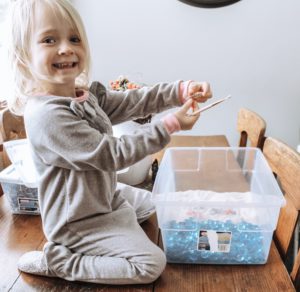
Sensory Play is a fun activity, and a learning tool all in one.
Any activity that stimulates your child’s five senses of touch, smell, sight, hearing, and taste, (although certain activities you may want to avoid the whole tasting part!) is considered a form of sensory play.
The activities involve some form of movement, meaning the child has a chance to develop fine and gross motor skills while playing. This kind of play is not only extremely entertaining for children, but it is also crucial for brain development.
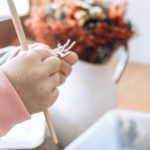
Think about how toddlers explore and learn about the world they live in. They touch, move, throw, pick up, taste, smell, listen to, and thoroughly examine every item that their tiny hands come in contact with! This is how they become confident with their surroundings and discover how their bodies work.
Sensory play encourages your child to explore, discover, and use scientific processes in a way that comes naturally to them, while also working their brains, and giving you a break from entertaining!
Benefits of sensory play
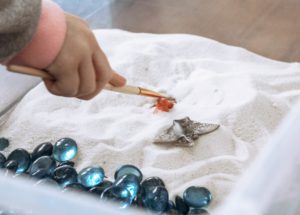
You may be thinking this sounds like a lot of work? But I promise you, it is worth your time and effort, and will save you all kinds of time in the future… Trust me.
I mentioned a few of the benefits of sensory play above, but let’s put them all together, and look at a few more.
- Encourages healthy brain development
- Helps to develop gross and fine motor skills
- Helps a child learn problem solving skills
- Supports language development and social interaction
- Leads a child into imaginary play. (Which research suggests is important for learning self- regulation of behavior and empathy towards others)
- Leads a child into open-ended play. (Which is play without a specific outcome or “destination” if you will.) The child can engage in self-lead play and explore with it, leading to several imaginative scenarios. They are not fed ideas on how to play, but rather they create ideas on their own. This aids in their development of self-confidence, independence, growing their imagination, and self-validating their experiences.
- It is a guilt free way to allow you to get some cleaning, work, or rest time in while your child explores and discovers! (But you should also join in on the fun when you can. Your kids will love sharing their imagination with you, and it is fun for adults to do sensory play too. It’s a great stress reliever!)
So now that we know how awesome sensory play is, lets talk about some favorites in our house, and I will include links for the supplies in case you’d like to put a few of them together yourself! 🙂
6 of our favorite go-to sensory play activities
Most of the activities that we do are what is called “sensory bins” meaning that we use plastic bins to contain the activity. It just makes it super easy to store them, reuse it at any time, and keeps the mess to a minimum.
1. Seaweed Animal Rescue.
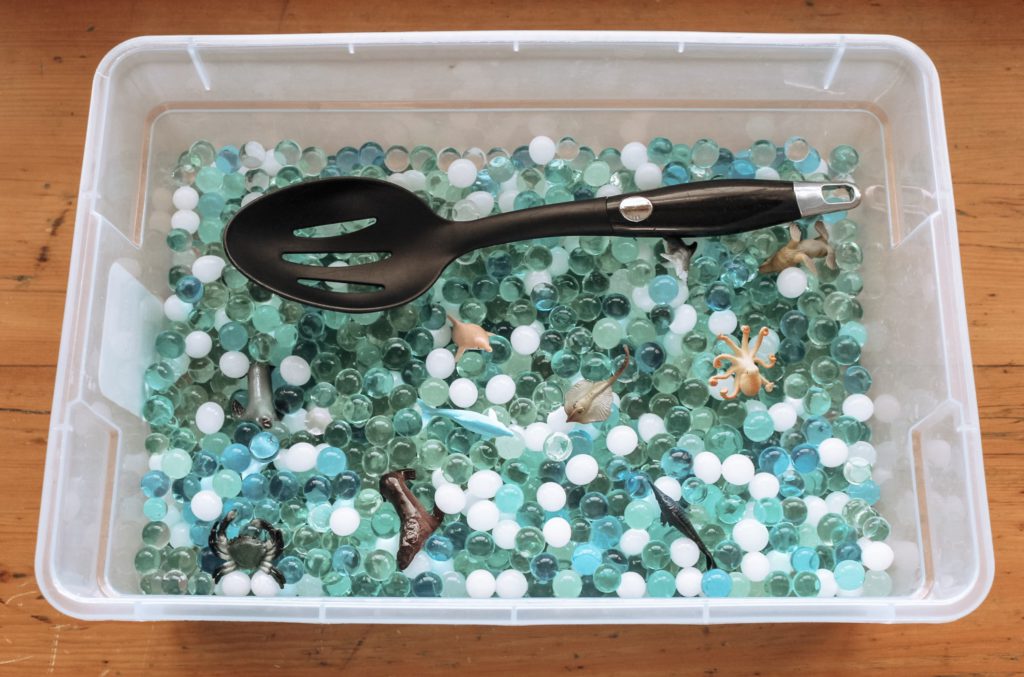
Seaweed Animal rescue is one of my daughter Honor’s favorites! This activity is very easy to throw together, and you probably have all the necessary materials already floating around your home.
We just grab a plastic storage bin, fill it with water, dye the water a pretty ocean-like color with food coloring, and then toss a bunch of small plastic sea creature animals inside. (Honor likes to add in non-sea creatures too… “just for fun” she says. Haha)
*TIP – switch the water out with water beads instead (Pictured above) if you don’t want to deal with wet floors! My kids LOVE water beads!
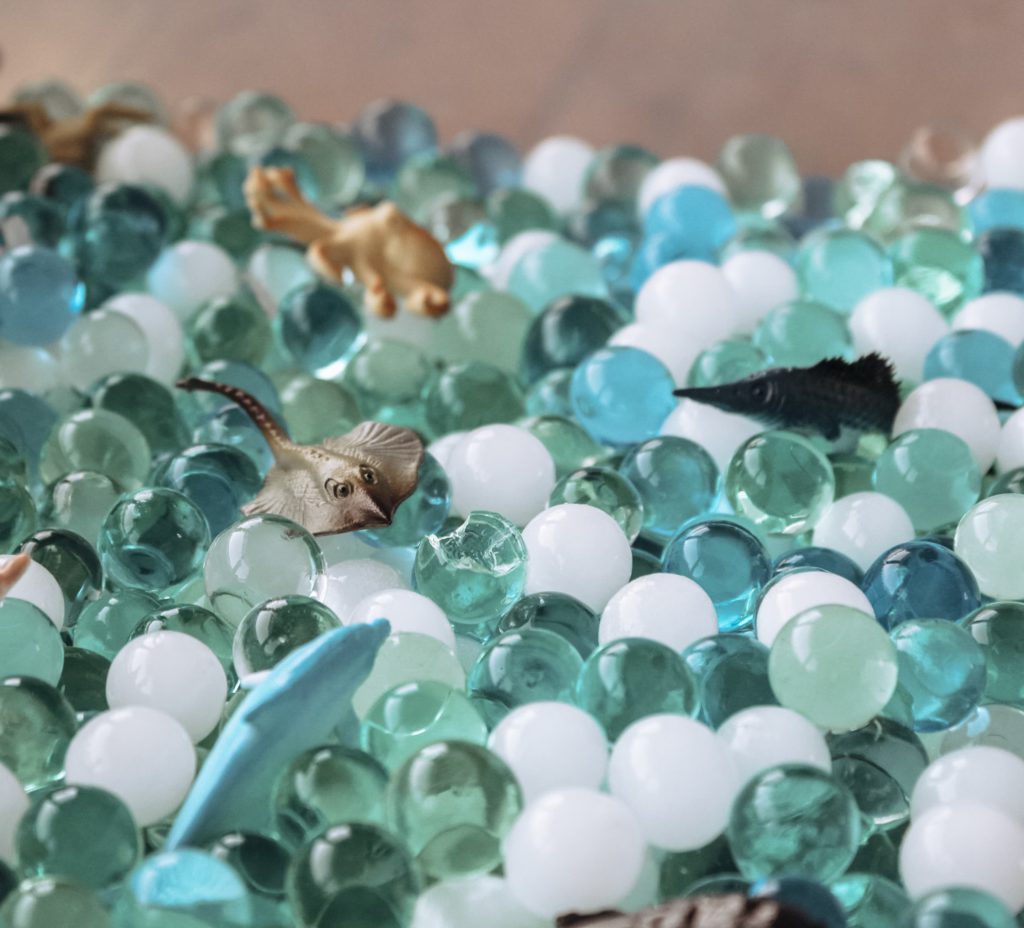
Sometimes, to make it extra interesting, we wrap the plastic animals up in pipe cleaners beforehand so that they look like they’re tangled in seaweed. Then I give the kids a slated spoon, tweezers, and a dry towel and she “rescues” the animals out of the water, tweezes off the “seaweed,” and dries them off with a towel. I also place a towel underneath the entire bin and put it on the kitchen floor just to keep things as dry, and mess free as possible.
This has kept Honor occupied for close to two hours before! She will repeat the steps, again, and again, and again. My son, Jesse, is only two years old, so it doesn’t occupy him quite as long, but I can usually get a good 30 minutes out of him too… or until he starts trying to climb into the bin of water, or splashes his sister with it…
Boys will be boys!
2. Seashell exploration.
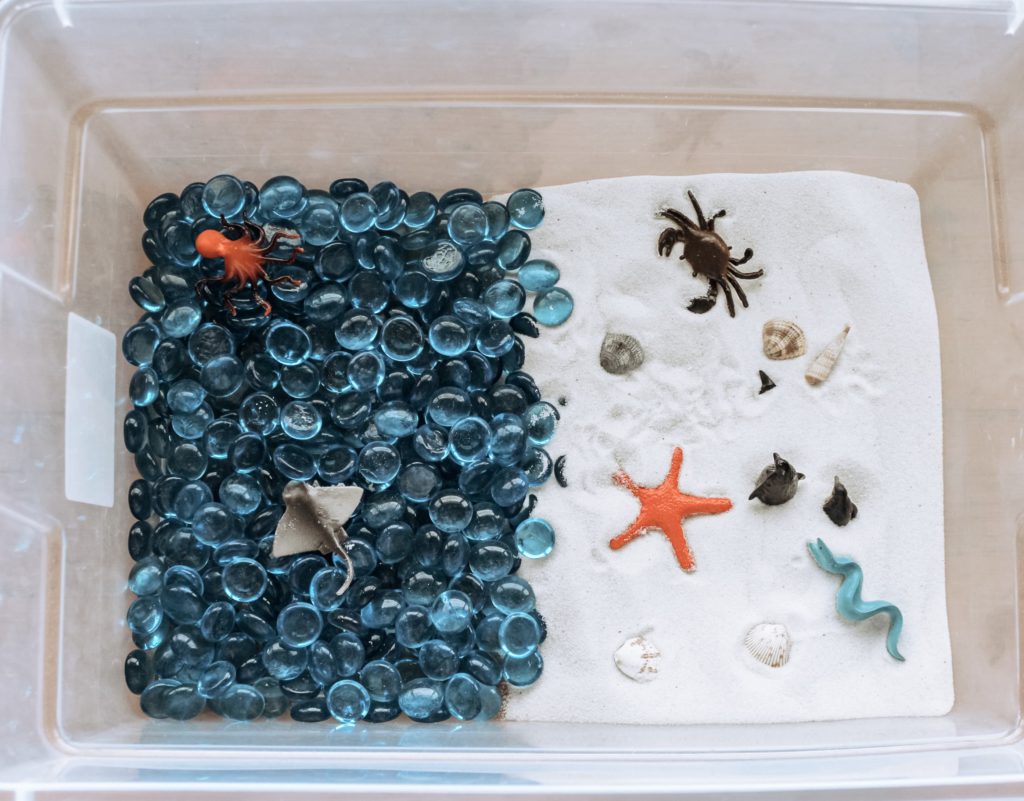
In one of our bins we like to keep play sand on one side, and turquoise glass beads on the other side (to look like the ocean) and then we bury seashells in the sand and in the ocean too.
Sometimes I even sneak in a shark tooth or two from our personal collection, which always surprises Honor and makes her super excited! I keep little digging tools in the bin so the kids can dig for buried “treasure” and find fun seashell discoveries!
This is very popular with both the kids. Jesse loves to dig, and Honor never gets tired of finding the seashell treasures!
3. Making molds in kinetic sand.
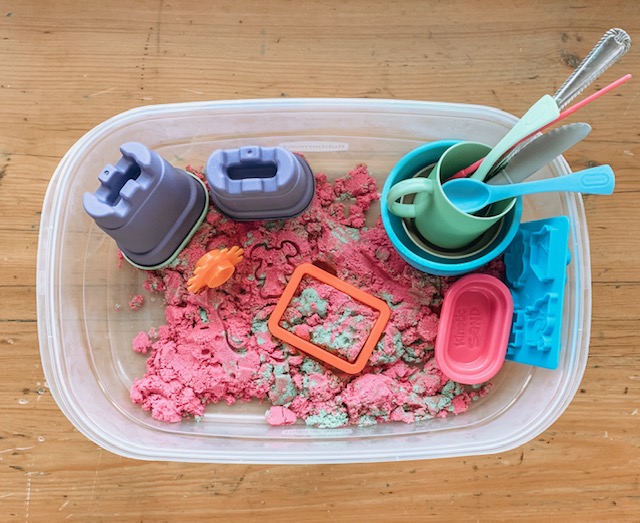
Have Y’all ever played with kinetic sand before!?
If not… you need to! It is so fascinating even to me as an adult! HA!
It is hard to explain, so you really should just pick some up and see for yourself, but this sand has its own interesting movement to it, and it is just neat to play with and watch how it moves.
Anyways… We have one bin that has kinetic sand, various molding shapes, stamping tools, and cups for pouring in it. The sand itself is fun, so you don’t really have to get too creative with this bin, and the kids will still enjoy it for several minutes!
*TIP – The sand bins can get a little messy, (but not as messy as normal sand) especially with toddlers. In the summer we do them outside, but in the winter, I just put it on a table with a towel under it and decide to be OK with a little mess. Although, I do not allow any complete bin dumping, of course. There still needs to be rules and boundaries!
4. Dried Beans and Boulder Construction Site
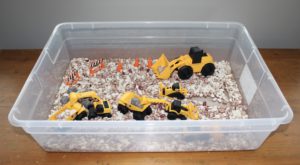
This is one of Jesse man’s favorites!
Of course, it involves construction trucks…
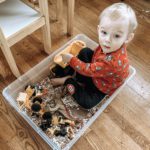
This bin is full of dried beans or lentils, whichever you prefer… stones from outside, and a handful of little construction vehicles! My kids have loads of fun pushing around the beans, scooping them into the dump trucks, and building hills and paths with the rocks.
In the summer I will sometimes fill half of the bin with dirt, so they can experiment with that texture as well, but in the winter, we typically stick to just the beans and rocks to avoid a mess of dirt in the house.
5. Digging for Dinos sensory bin.
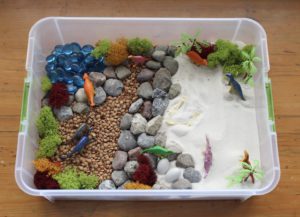
I’ll admit. This is one of MY favorites! 😀
The kids and I have a blast setting up the Dino habitat and then digging for Dinosaur bones in the sand section of the bin.
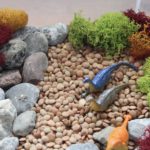
This bin has sand, rocks, dried lentils, preserved moss, some glass beads, fake Dino bones, and plastic dinosaurs too!! Sometimes we add in dirt as well, or real grass if we’re outside. The idea is to just be creative and have fun with them!
I keep digging tools, and little paint brushes in this bin also so the kids can dig for dinosaur bones and carefully brush them off to see what they have discovered!
6. Baby Chick Hatchery bin
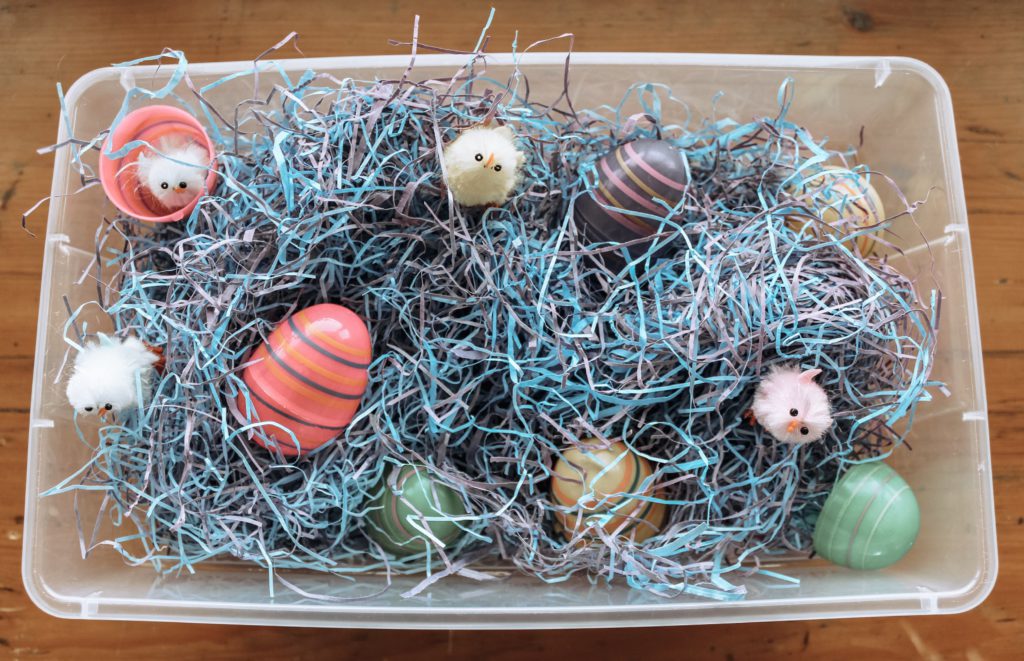
This one is just super cute. We filled a bin with the Easter grass that you put in Easter baskets, and put in fun colored Easter eggs that have adorable little fluffy toy chicks inside that I found on Amazon!
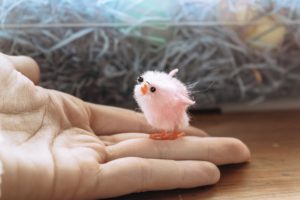
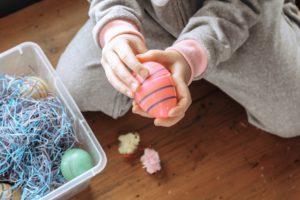
Honor loves to pretend the baby chicks are hatching, and then she plays with them in the fake grass afterwards as well!
Jesse loves to throw the eggs… but we’re working on it. 😉
Supervision for babies/toddlers
This is a bit obvious, but it’s easy to see that most sensory activities include small pieces. For this reason, I do not leave my two-year-old unsupervised with a sensory bin.
Plus, I want to make sure he’s not making a huge mess.
Once my daughter was three, I could trust her much more, and now that she is four, she can safely do a sensory bin on her own while I am just nearby.
That’s all folks!
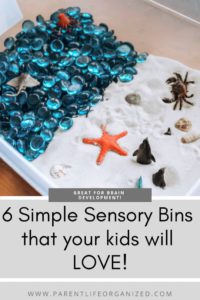
I hope we have given you some good ideas for creating your own sensory activities with your little ones!
Sensory play is a great investment for your kiddos. It will keep their minds engaged, and their little hands busy. This alone makes it totally worth the time to put the activities together, and it allows for fun time spent together creating the different bins as well!
We love to post our new sensory bin ideas on Instagram, Facebook, and Pinterest, so be sure to follow us there if you liked this post! 🙂
Tell us your favorite sensory play activities in the comments below!
Never miss a post…
Other Posts I think you would Enjoy!
– How to stay productive as a WAHM, without going totally crazy…
– Why you should wake up BEFORE your kids, and how it totally changed my life.
